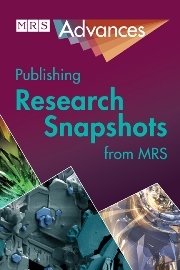Article contents
Metallographic, Structural and Mechanical Characterization of REM-Containing Fe-30Mn-8Al-1.8C Low Density Steel in As-Cast Condition
Published online by Cambridge University Press: 11 January 2019
Abstract
Recently, low-density steels have received increased attention as promising alternatives for automotive applications of the next generation of Advanced High-Strength Steels (AHSS), considering that vehicle´s weight decrease has been the subject of intense interest. It is well-known that the addition of rare earth metals (REM) has a remarkable effect on shape control and the modification of inclusions. Also, REM additions affect the grain size refinement as well as the tendency to form oxides and sulfides. The aim of this research work was to determine the effect of REM (Ce, La) addition on the microstructure and mechanical properties of the Fe-30Mn-8Al-1.8C low-density steel in as-cast condition. In order to clarify the REM effect on the Fe-Mn-Al-C system, non-microalloyed (LD-NM) and REM microalloyed (LD-REM) specimens were examined in detail by means of light optical and scanning electron microscopy for microstructural characterization. In the same way, the primary and secondary phases founded in the studied steels were identified by X-ray diffraction (XRD). Meanwhile, in order to evaluate the mechanical properties, ten microhardness measurements were carried out on the overall bulk by the Vickers hardness testing. In general, the results showed a dendritic refinement effect due to the addition of REM to low-density steel. REM acted as effective inoculants agents which reduced the primary and secondary arm spacing. Also, the strong segregation tendency at the grain boundaries in the liquid phase was limited. XRD profiles revealed the presence of austenite, ferrite, κ and DO3 phases. Low density steel microalloyed with REM showed a moderate increase in hardness compared to the non-microalloyed steel in the as-cast condition.
Keywords
- Type
- Articles
- Information
- MRS Advances , Volume 3 , Issue 64: International Materials Research Congress XXVII , 2018 , pp. 3957 - 3962
- Copyright
- Copyright © Materials Research Society 2019
References
- 2
- Cited by


